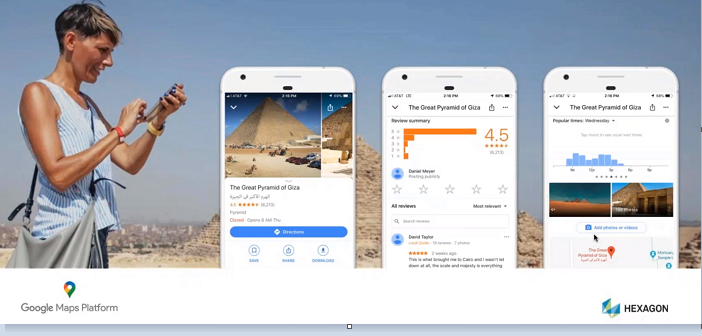What makes a place a place? An address? It’s surroundings? The details you need to get there?
The answer can be all of this and more, according to Google Places. Google Places is one of three core products offered through the Google Maps Platform. Originally introduced in 2010, Google Places is Google’s incredibly massive point of interest or POI database.
Google Places features 150 million different places, over 28 million updates every single day, and over 1 billion monthly active users. With this product, you can provide users with data like location names, addresses, user ratings, reviews, contact information, and atmosphere to help them explore the entire world around them.
The incredibly flexible nature of the Google Places API offers links to all of these data fields together, giving you access to different types of search capabilities to return exactly what your users are searching for.
Reliable Location Data Right When Your Users Need It
Google dedicates a lot of resources to building and maintaining the Google Places database. So when a new business appears online, a new building is built, or a new neighborhood is constructed, you can count on accurate, reliable, constantly updated information.
The team keeping the database current includes:
- Local guides – 60 million global contributors are constantly adding over 20 million contributions per day – things like reviews, star ratings, photos, and descriptions – to the Google Places data.
- Google My Business Program – businesses understand how important Google searches are, so they’re incentivized to give Google the best information about their business, such as when they open and close.
- Google staff updates – When people start searching for something that’s not in Google Places, Google’s staff can detect that a new business has been created, and they go out and find it.
- Street View cars – Google staff also drives Street View cars all over the world, which are equipped with cameras to gather imagery for the database. Google’s leading machine learning technology reads what’s in the images, including things like the street number that might be on the door and even the opening and closing hours, to update the database.
Real-World Examples of Google Places in Action
Some say that Google Places is Google Maps’ most valuable asset, but it is also one of Google Maps’ more complex offerings. That’s where the benefit of implementing the Google Maps Platform with the help of a Google-certified Partner comes in.
Take a look at what some of our customers have accomplished with Google Places.
CreditOne
CreditOne, a credit card company, uses the auto-complete capability in Google Places. This is the action of typing in characters and having Google predict what you’re typing, then convert it into an address or the name of a business.
This provides their customers with two huge benefits. First, it’s a better user experience – less typing and less opportunity for people to make mistakes.
The other benefit is that when you pick an address through the Places API, the number, the street name, and the prefects are standardized for more consistent data.
Mozio
Mozio is an online company that can get you airport transport wherever you may be going. You type in the name of the city, and it finds your local airport. You can then begin typing the name of a destination, like your hotel, to find it. Mozio connects you to the different kinds of suppliers of airport transport and then shows you a map with the airport location at the start of your journey and the hotel location at the end. The search result comes back with many options, and you pick the one that fits your price point and other criteria.
Mozio also uses custom styling instead of the traditional Google Maps colors to better fit their brand.
Spot Hero
Spot Hero, which is a mobile app for finding parking, uses a wide variety of Google’s APIs. They use Google Places auto-complete to show where the parking is located. They use Places API to show details such as the star ratings that are within Google Places. They also use the distance matrix to find the nearest parking lots to your current location. They present all of this data in a map using the Maps API.
Learn More About Improving Your Customers’ Experience
Google Places provides premium data content that you can leverage into your own website and apps. It’s not just the points of interest themselves. It’s a suite of capabilities, including geocoding and auto-complete, times zones, and so forth.
It’s a complicated API. It can be challenging to implement efficiently, but there are best practices out there to help you optimize your experience.
In our webinar, we explore all the benefits you can see with Google Places, as well as why you should work with a Google-certified Partner to implement it.
Contact us today to get started with Google Places.
















